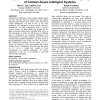322 search results - page 22 / 65 » An Example of an Automatic Differentiation-Based Modelling S... |
SOSYM
2008
14 years 10 months ago
2008
Amodelisasimplifiedrepresentationofanaspect of the world for a specific purpose. In complex systems, many aspects are to be handled, from architectural aspects to dynamic behavior,...
103
click to vote
ECAI
2006
Springer
15 years 1 months ago
2006
Springer
This paper addresses the problem of categorizing terms or lexical entities into a predefined set of semantic domains exploiting the knowledge available on-line in the Web. The prop...
CHI
2009
ACM
15 years 10 months ago
2009
ACM
Context-aware intelligent systems employ implicit inputs, and make decisions based on complex rules and machine learning models that are rarely clear to users. Such lack of system...
IROS
2009
IEEE
15 years 4 months ago
2009
IEEE
Abstract— Previous work [1] shows that the movement representation in task spaces offers many advantages for learning object-related and goal-directed movement tasks through imit...
VIROLOGY
2008
14 years 10 months ago
2008
We present a novel classification of computer viruses using a formalised notion of reproductive models based on Gibson's theory of affordances. A computer virus reproduction ...

